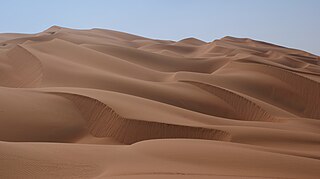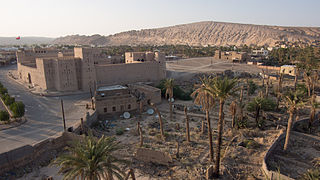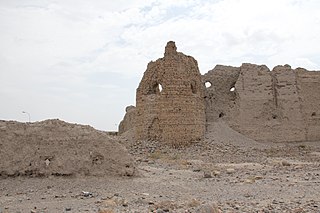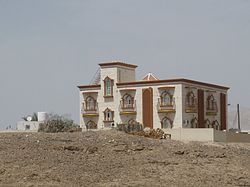
Oman is a country on the southeast coast of the Arabian Peninsula, situated in West Asia, bordering the Arabian Sea, Gulf of Oman, and Persian Gulf, between Yemen and the United Arab Emirates (UAE). The coast of Oman was an important part in the Omani empire and sultanate.

Muscat is the capital and most populated city in Oman. It is the seat of the Governorate of Muscat. According to the National Centre for Statistics and Information (NCSI), the total population of Muscat Governorate was 1.72 million as of September 2022. The metropolitan area spans approximately 3,500 km2 (1,400 sq mi) and includes six provinces called wilayats, making it the largest city in the Arabian Peninsula by area. Known since the early 1st century AD as an important trading port between the west and the east, Muscat was ruled by various indigenous tribes as well as foreign powers such as the Persians, the Portuguese Empire and the Ottoman Empire at various points in its history. A regional military power in the 18th century, Muscat's influence extended as far as East Africa and Zanzibar. As an important port-town in the Gulf of Oman, Muscat attracted foreign tradesmen and settlers such as the Persians, Balochs and Sindhis. Since the accession of Qaboos bin Said as Sultan of Oman in 1970, Muscat has experienced rapid infrastructural development that has led to the growth of a vibrant economy and a multi-ethnic society. Muscat is termed as a Beta - Global City by the Globalization and World Cities Research Network.

Al Ain is a border city on the eastern side of Tawam oasis and the seat of the administrative division, the Al Ain Region, in the Emirate of Abu Dhabi, United Arab Emirates. It is bordered to the east by the Omani town of Al-Buraimi in the Al Buraimi Governorate. It is the largest inland city in the Emirates, the fourth-largest city, and the second-largest in the Emirate of Abu Dhabi. The freeways connecting Al-Ain, Abu Dhabi, and Dubai form a geographic triangle in the country, each city being roughly 130 kilometres (81 mi) from the other two.

The Rub' al Khali, the "Empty Quarter") is the sand desert (erg) encompassing most of the southern third of the Arabian Peninsula. The desert covers some 650,000 km2 (250,000 sq mi) including parts of Saudi Arabia, Oman, the United Arab Emirates, and Yemen. It is part of the larger Arabian Desert.

The Emirate of Fujairah is one of the seven emirates that make up the United Arab Emirates, the only one of the seven with a coastline solely on the Gulf of Oman and none on the Persian Gulf. Its capital is Fujairah.

Nizwa is the largest city in Ad Dakhiliyah Region in Oman and was the capital of Oman proper. Nizwa is about 140 km (87 mi) from Muscat. The population is estimated at around 83.544 people.
The Education in Oman is provided free of charge up to end of secondary education, though attendance is not mandatory at any level. In 1970 there were only three formal schools with 900 students in the whole state. Oman's national educational program expanded rapidly during the 1970s and the 1980s, with the Kingdom of Saudi Arabia sending teachers on its own expense during that time period. In 2006–2007 about 560,000 students attended 1053 public schools. The number of students in private schools is about 65,000. There are also extensive programmes to combat adult illiteracy. Sultan Qaboos University, the only national university near Muscat, was founded in 1986, and in 2006 it had 13,500 students. The Human Development Report found the literacy rate to be 93.0% in adults, up from 54.7% in 1990. For the same period, the youth literacy rate increased from 85.6 to 97.3%. Public expenditure on education was reported to be 4.6% of GDP and 26.1% of total government spending.

Rustaq is a town and Wilayah (District) in Al Batinah Region of northern Oman. The wilayah is in the Western Hajar Mountains, in the south of the Batinah. Rustaq was once the capital of Oman, during the era of Imam Nasir bin Murshid al Ya'arubi. Rustaq Fort, built four centuries prior to the 7th century CE, is an imposing structure built on three levels, containing separate houses, an armoury, a mosque and four towers. The tallest tower stands over 18.5 m (61 ft) high, and has a diameter of 6 m (20 ft).

Sur is the capital city of Ash Sharqiyah South Governorate, and the former capital of Ash Sharqiyah Region in northeastern Oman, on the coast of the Gulf of Oman. It is located about 126 mi (203 km) southeast of the Omani capital Muscat. Historically, the city is known for being an important destination point for sailors. Today, the sea still plays an important part of life in Sur.

Ibri is a city and Wilāyat (Province) in the Ad Dhahirah Governorate, in northwest Oman.

Izki is a town in the region Ad Dakhiliyah, northeastern Oman. It is located at c. 544 m (1,785 ft) altitude, and has a population of 35,173 (2003 census).
Adam is a town in the region Ad Dakhiliyah, in northeastern Oman.

Al Hamra is a 400-year-old town in the region Ad Dakhiliyah, in northeastern Oman. As a province (wilayat), it is home to a number of villages including the mountainside village of Misfat Al Abryeen, with the village of Ghul to the northwest of the town, and Bimah to the north-northeast. The town and province lie on the southern slopes of the Akhdar Mountains.

The present-day Sultanate of Oman lies in the south-eastern Arabian Peninsula. There are different definitions for Oman: traditional Oman includes the present-day United Arab Emirates (U.A.E.), though its prehistoric remains differ in some respects from the more specifically defined Oman proper, which corresponds roughly with the present-day central provinces of the Sultanate. In the north, the Oman Peninsula is more specific, and juts into the Strait of Hormuz. The archaeology of southern Oman Dhofar develops separately from that of central and northern Oman.

Saint Catherine is a town in the South Sinai Governorate of Egypt, situated at the foot of the mountain Mount Sinai. The city is the site of Saint Catherine's Monastery. The city is 1,586 metres (5,203 ft) above sea level and is 120 kilometres (75 mi) from Nuweiba. In 1994, its population was 4,603 people. In 2002, The Saint Catherine area has been declared a UNESCO world heritage site.
Al Awabi is one of the 62 provinces (wilayat) of Oman. It is located in Al Batinah Region, north of Oman. Based on the figures of the 2020 census, Al Awabi is home for 18,833 people, compared to 10,469 in 2003. It has 32 villages.

The community of Indians in Oman includes Indian expatriates in Oman, as well as Omani citizens of Indian origin or descent.
Tanam or Tan`am is a village in Ad Dhahirah Region, in northeastern Oman. The village lies just southwest of the town of Ibri in Wadi Aswad. The village is described as "little more than an oasis surrounded by block house" It is an important centre for date production and contains a notable population of Duru peoples, especially since the 1970s, when the gather during the date harvest but then return to their nomadic life." The village contains Tanam Hospital, a 200-bed hospital. The hamlet of Dubayshi lies to the north and the hamlet of Khuldah immediately west.

The Archaeological Sites of Bat, Al-Khutm and Al-Ayn are a group of beehive tombs or necroploeis from the Hafit period in the 3rd Millennium BC, located near a palm grove in Oman. They were declared World Heritage by UNESCO in 1988.
Dhank is a wilayah (province) of Ad Dhahirah Governorate in Oman. It borders the provinces of Al Buraimi on the northwest, Ibri on the southwest and Yanqul on the east. It has many valleys, such as Wadi Al Fateh and Wadi Qumeirah.
















